The most common mushrooms in Finland to harvest include chanterelles and boletes. We Finns are crazy about mushrooms, and we even pick many poisonous mushrooms. Consuming poisonous mushrooms is safe only if you know your mushrooms. Like Kimi Räikkönen used to say: “Leave me alone, I know what I’m doing.”
Here are some of our most commonly harvested mushrooms and few tips for identifying and cooking them. Important reminder: If you are not 100% certain that you recognize your mushrooms and know how to prepare them, do not eat them. The site takes no responsibility for damage caused by wrong identifications or preparations. If you are beginner with mushrooms, it is best to ask someone to confirm your mushroom identifications.
The easiest mushrooms to pick include chanterelles and hedgehogs
Let’s start with the easy ones that most Finns like to pick. Chanterelles, funnel chanterelles, and black trumpets have funnel shape and gills underneath the cap. Hedgehogs have teeth underneath that look like hedgehog spikes.
Chanterelle (Cantharellus cibarius)
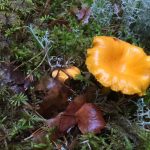
The chanterelles are one of the most delicious wild mushrooms in Finland. And easy to recognize, if you a planning to start a mushroom forager career. It is a common and easily distinguished by its egg yolk yellow colouring and funnel shape. Underneath the smooth cap, chanterelles have forked gills that run almost all the way down the stem. They can be found in mixed or birch forests, and they prefer bright areas. Usually chanterelles are found in the same locations year after year, so take a note of the location if you found some. The best time to pick them is from end of August to September. They can also be found later, and they are usually free from worms, so therefore edible even when they are older. Chanterelles are especially delicious when fried in butter. I like to add them to pizzas and omelettes. They can be frozen uncooked or cooked, but get leathery when dried.
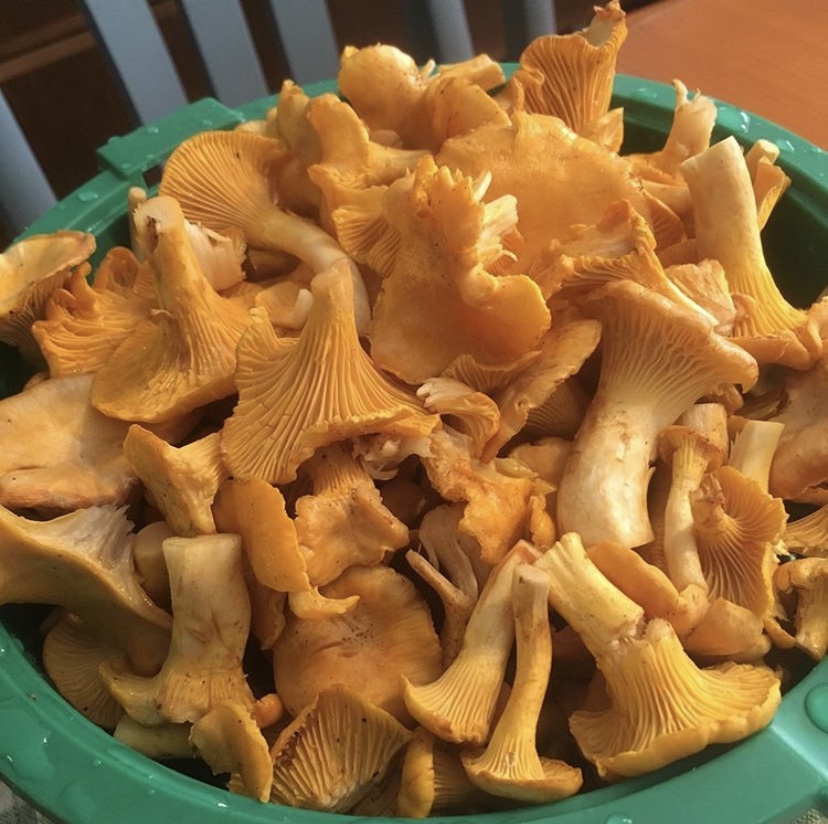
There is also a mushroom called false chanterelle. It is edible but not as superior in flavour as the real thing. It is usually more orange than chanterelle, often has a very round shape, which chanterelle only has when it’s young, and it has more straight stem. It is easy to tell them apart if you have them side by side, but when you are in the forest, looking for chanterelles, you might easily mix the two. But don’t worry, the false chanterelle won’t kill you.
Hedgehog mushroom (Hydnum repandum)
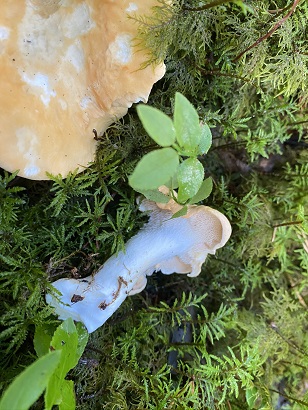
The hedgehog, or sweet tooth, is the most foolproof to identify of all wild mushrooms in Finland. There are few other fungus of the family Hydnaceae, including darker Hydnum rufescens, but none of them are poisonous ones. Hydnum rufescens is actually equally delicious. Therefore you should start with the hedgehog if you are unsure of what to pick.
The hedgehog has light yellow cap and it is often weirdly shaped. The hedgehog has many toothbrush-like teeth on the underside. Stem is all white. Once you see teeth, you know you have found the hedgehog. Hedgehog can be picked at the same time as chanterelle, from end of August to September. It likes moist soil.
You should know that radioactive Cesium-137 from Chernobyl fallout can be found in some mushrooms more than others. The hedgehog is one of those mushrooms that has bigger concentrations of Cesium-137. You can reduce the amounts of Cesium by soaking or boiling the mushrooms in water before consumption. If you are worried, read more from STUK website.
Funnel chanterelle (Craterellus tubaeformis)
Funnel chanterelles, also known as trumpet chantarelles, are shaped like a funnel, similarly to yellow chanterelles. They are brown, light brown or greyish brown in color, stem is hollow, rather slim, and has a yellow colour. Funnel chanterelles love mossy woods, spruce but also in mixed forests. They grow in large groups in the same places year after year. Once you find a good spot, you can easily gather your basket full. I recognize funnel chantarelle spots by their smell. The smell and taste are stronger than what yellow chanterelles have. Their harvesting season is later than chantarelles, starts in September and lasts until the temperature goes down or we get snow on the ground. Funnel chanterelles can be stored dried or frozen. I like to use dried funnel chantarelles in meat stews or sauces as they bring a lot of flavors.
Funnel chanterelle’s lookalike is wetland chanterelle, which grows on more moist environments. It is equally delicious and safe, but can be told apart by its brown or greyish brown stem and color.
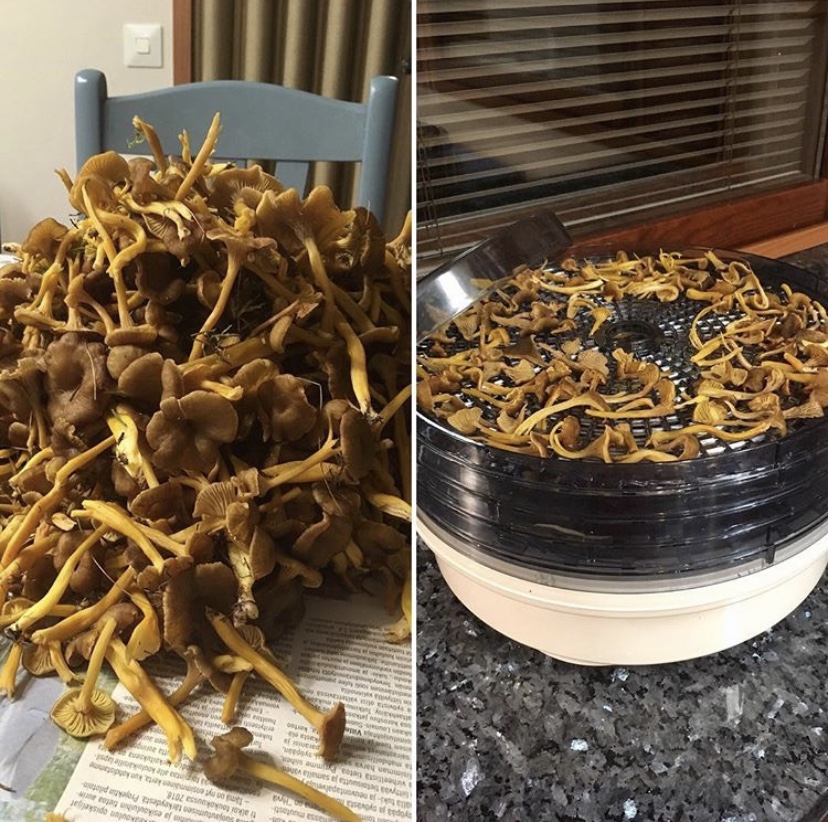
Black trumpet (Craterellus cornucopioides)
The black trumpet, also known as horn of plenty, looks pretty bad. It’s black and grey, kind of like soft chanterelle and doesn’t even look edible. But the looks can be deceiving. It is actually delicious and 100% edible. The black trumpets grow in groves or bright spruce forests. If you manage to find one, the changes are that there is an army of them close by. But they are not the easiest ones to spot. They can be found at the same time as chanterelle, early autumn. The black trumpet is as versatile as chanterelle, and it can be dried too. Drying actually makes the taste even better, because it is quite subtle in flavor. The stem is usually dirty and tastes a bit like mud, so you can cut part of them away when cleaning the black trumpets.
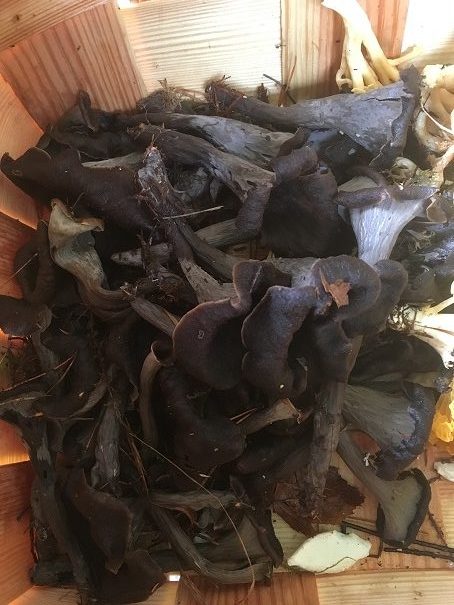
Boletes are Finland’s finest mushrooms
The boletes are easily recognizable by having small pores instead of gills on the underside of their caps.
Penny bun (Boletus edulis)
The penny bun is regarded in Finland as the king of all boletes. Worms love it too, so you should pick it when it’s young. The season of Boletus Edulis and all boletes in Finland is usually from middle of July to the end of October. The fungus grows in deciduous and coniferous forests.
I like to check out if the sturdy stem has a white net on it right underneath the cap. It is the best tell for the penny buns. If the bolete doesn’t have that white net but rather dark spots in its stem like birch boletes below, the bolete is likely bitter bolete or birch bolete. Tasting it confirms it, and bitter boletes can be left out of the frying pan.
The Finnish name for the penny bun is herkkutatti. Herkku means delicious, and tatti describes the type of mushroom, bolete.
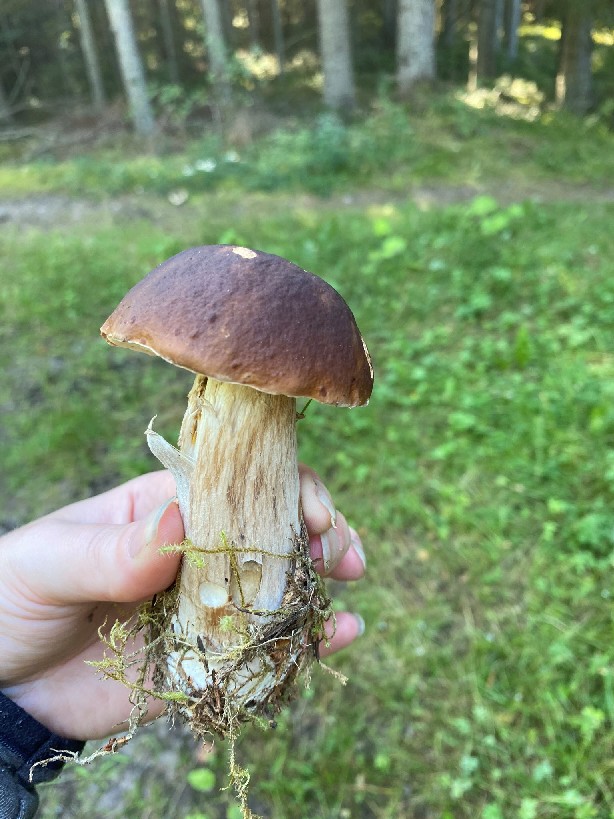
Birch bolete (Leccinum scabrum)
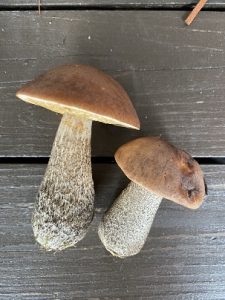
The birch boletes have dry caps and dark dots in the stem, and the flesh does not change color when broken. They are much less valued than penny buns but they can be eaten if you happen to pick them in your basket.
These edible boletes should not be mixed with bitter bolete, Tylopilus felleus, which is also common. It is not poisonous but it has a bitter taste that ruins your food. Bitter bolete turns red when cut. And tastes bitter also raw. Another bad tasting bolete is Chalciporus piperatus, which is slimy, light brown bolete with a narrow stem.
Mottled bolete (Leccinum variicolor)
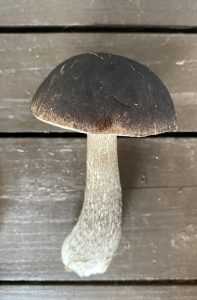
The mottled bolete has various shades of grey or dark grey-brown caps and lighter color stems. Variicolor is actually a reference to the very variable cap colouring of this species. The stem flesh is white but sometimes turns pinkish in the upper section when it is cut or broken, while near to the stem base the cut flesh turns blue. Pores are white, but when bruised, the pores gradually turn brownish. Talking about variable colors!
The mottled bolete grows next to birch trees all around the country. It has to be cooked properly like all Leccinum mushrooms, and it can be stored frozen or dried.
Orange birch bolete (Leccinum versipelle)
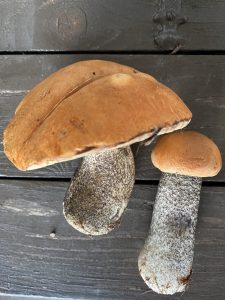
The orange birch bolete is easy to find due to its orange color and height. Seriously, this mushroom is getting to my face where-ever I go. One good tell is that its flesh turns purple or blue when cut. As most boletes, it is tasty, but mildly toxic and should be boiled or fried for 15-20 minutes for your tummy’s sake. It changes color to dark when cooked, so it is not the prettiest mushroom to eat.
Pine, oak, and aspen have their own boletes too, and they are edible. It is common that the flesh in them gets dark when cut. Pine bolete is the darkest one, dark brown with similar stem as the orange birch bolete.
General rule: Don’t pick white mushrooms
We Finns have heard warnings about white mushrooms since childhood. Stay faaaaar away from a destroying angel, Amanita virosa. This white mushroom is NOT a portobello NOR a champignon. It can kill an adult human.
But there is one white mushroom, that I can recommend:
Forest lamb (Albatrellus ovinus)
I used to stay away from white mushrooms for a long time, because one of the most poisonous and deadly mushrooms in Finland is white. But then I learned to recognize the forest lamb, also known as sheep polypore, and became a fan. The forest lamb has an irregular shape kind of like the hedgehog mushroom, and dirty white colour. It may grow up to twenty centimetres in diameter. It grows in clusters in coniferous forests from end of August to September. It is good when fried, and but it can also be dried, pickled, or frozen in its own broth after being brought to a boil. I highly recommend trying this mushroom fried with a parmesan, flour and parsley crust after you have dipped it in egg. It’s a steak like no other. This is my favourite mushroom due to its hard texture.
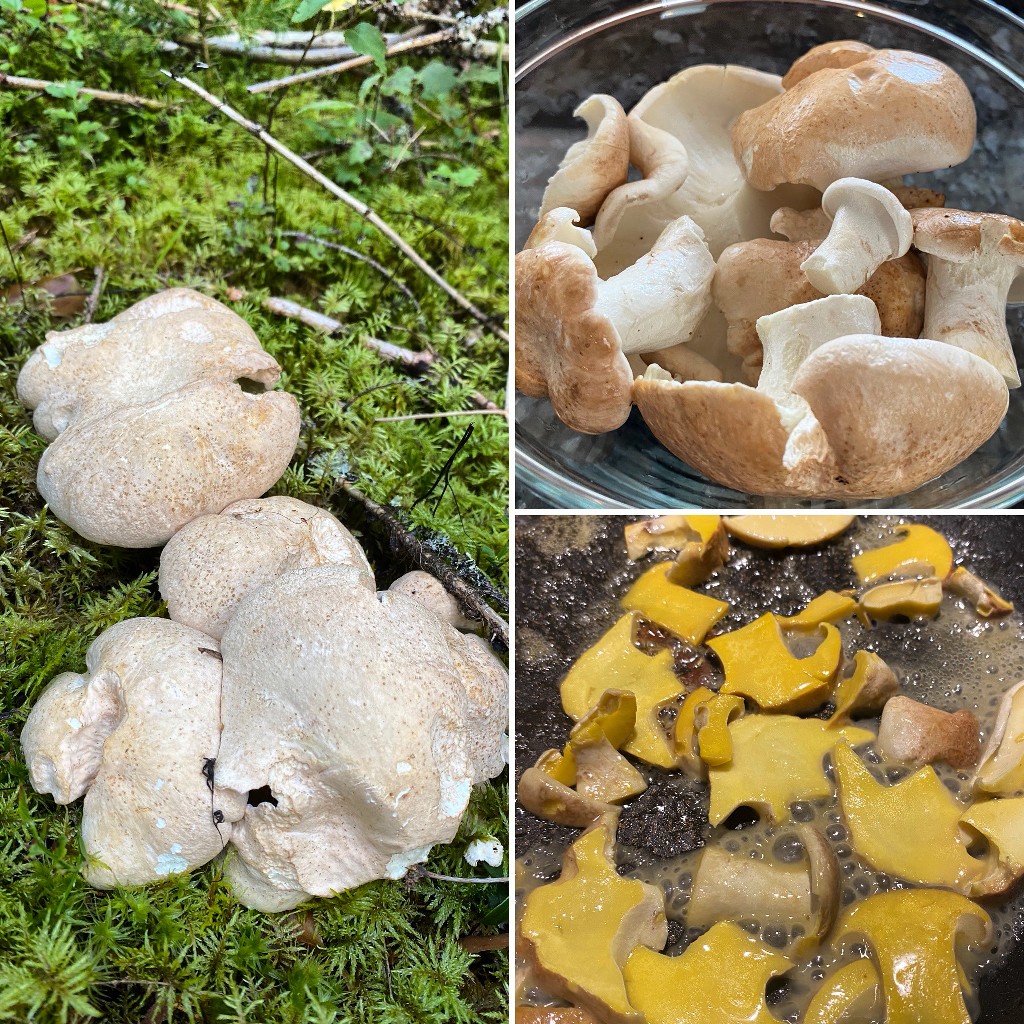
The forest lamb can be easily mixed with another polypore Albatrellus confluens, which is slightly darker in color and doesn’t turn yellow when cooked. That one doesn’t taste good at all.
There are many russulas
The genus Russula is sometimes known colloquially as brittle gills. They are often large and strikingly colored. Finns like to collect many russulas for food but you should advise caution with them.
Tall bog russula (Russula paludosa)
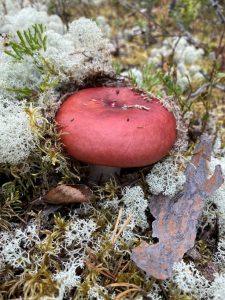
The tall bog russula, Russula paludosa, is a tasty treat. Tall bog russulas have gorgeous red caps and white stems with a hint of pink. The cap can turn to yellow from the middle as they get older. One easy sign is, that tall bog russula remains white when you cut it. It also has a mild taste. Tall bog russula can be dried for later use.
These russulas can very easily be mistaken with Russula emetica. It is also known as the sickener, which should tell you something. Russula emetica is poisonous and has a very peppery taste. Not that those things would prevent us from eating them, too.
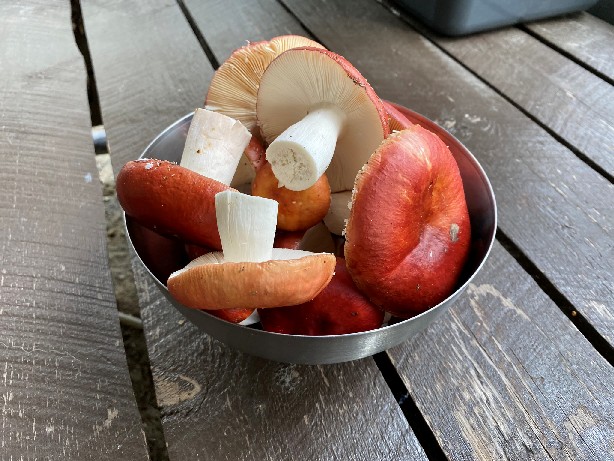
Milkcaps exude milky liquid
Milkcaps are easily identified by the droplets of milky liquid they exude when they are cut. Many milkcaps are toxic and need to be boiled before use.
Rufous milkcap (Lactarius rufus)
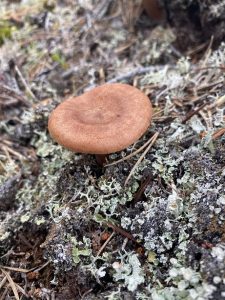
The rufous milkcap is dark brick red in color, and grows often in groups in dry pine forests. It is common throughout the country and can be identified by white milky liquid when it’s cut. Because it is easy to find, it has traditionally been used a lot even though the taste can be bitter and peppery. It is also poisonous and needs at least 10 minutes of boiling before use. But after boiling it can be pickled in vinegar or stored in salt water. Milkcaps are best in creamy mushroom salads with onion.
Cortinarius rubellus, commonly known as the deadly webcap, might look similar to the rufous milkcap from the top, but it doesn’t have white milky liquid inside. The deadly webcap doesn’t have a strong taste. But do not eat it! The danger of the deadly webcap was first recognized in 1972 in Finland, where four cases of poisoning had occurred, two of which resulted in permanent kidney failure. Other nationalities have also f*ucked up with the deadly webcaps since then.
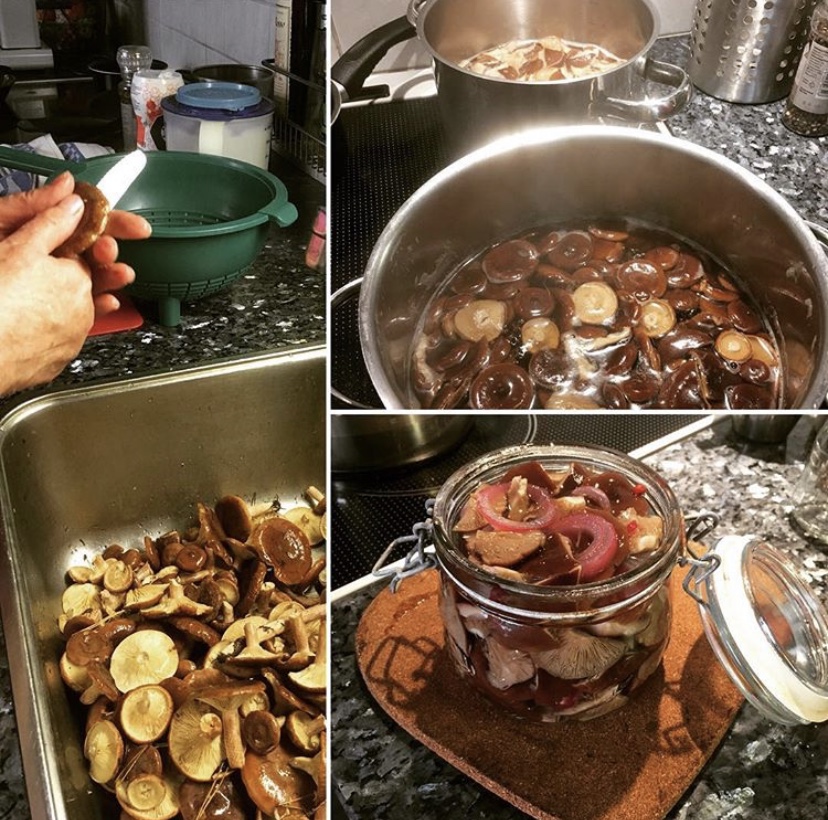
Woolly milkcap (Lactarius torminosus)
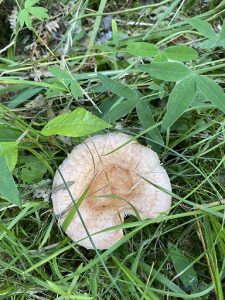
The woolly milkcap is used similarly to the rufous milkcap. It is valued for its peppery flavor and eaten after suitable preparation in Finland, and Russia – they are crazy too. But you should know that the species is highly irritating to the digestive system when eaten raw. The toxins, also responsible for the strongly bitter or acrid taste, are destroyed by cooking.
The woolly milkcaps are easy to recognize by their pinkish cap and tomentose structure that partly covers up the gills.
Mushrooms grow also in spring
Mushroom season can start as early as May when false morels begin to emerge.
False morel (Gyromitra esculenta)
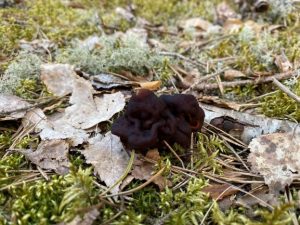
False morels are often found in sandy forest bed and they are pretty easy to identify. They are dark brown or brown in color and texture resembles brain. This highly valued and tasty mushroom is poisonous when not prepared correctly; it has to be boiled and rinsed at least two times before utilisation. This method takes away most of the toxins. It is also recommended to pick this mushroom separately from any other mushrooms or berries so it doesn’t contaminate them. But that applies to many other mushrooms too.
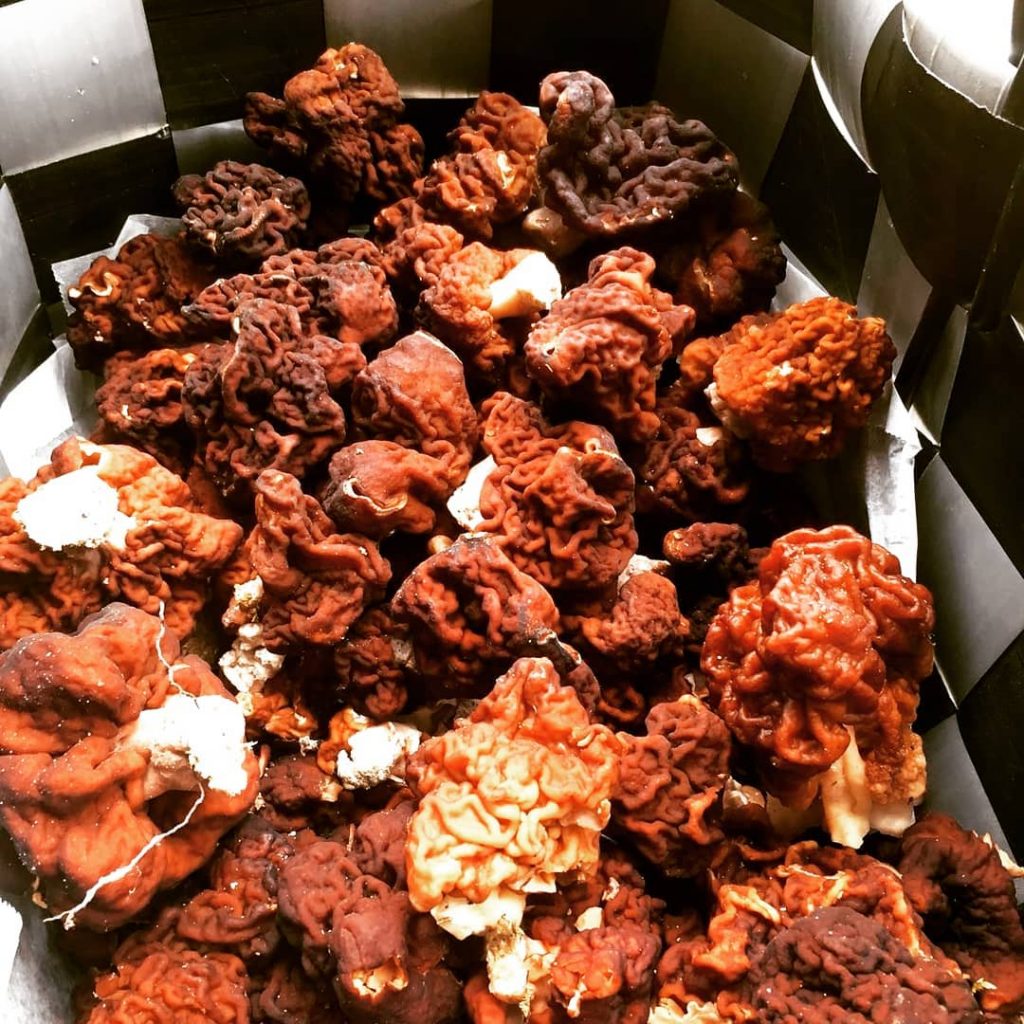
One other very common and highly valued mushroom in Finland is gypsy mushroom, Cortinarius caperatus. I have seen it many times and I think I recognize it, but I don’t dare to pick that one since it is part of the genus Cortinarius, which usually are toxic and dangerous. It was in fact known as Rozites caperata for many years before genetic studies revealed that it belonged to the genus Cortinarius. It is not for the beginners. Equally, Macrolepiota procera, the parasol mushroom, is also sought-after. Many Finns also pick Chlorophyllum olivieri, the shaggy parasol, which is toxic. I wouldn’t recommend neither of them for inexperienced hunters. One highly valued mushroom is matsutake, Tricholoma matsutake. It is a large mushroom with a strong aroma, usually found with pine trees on a sandy soil.
In Finland, everyman’s rights allow anyone to pick mushrooms freely, even on privately owned land. Not in yards or gardens, so always leave enough distance to the closest properties. We Finns like our personal space.
Read more about mushrooms
- Watch out for the deadliest mushrooms in Finland
- How to identify different milkcaps in Finland
- How to identify edible boletes in Finland
- What is the difference between true morels and false morels?
- How to tell chanterelle and false chanterelle apart
- Colorful brittlegills are a fascinating family of mushrooms
- Cep or bitter bolete? How to tell the difference
Fun mushroom quizzes
- Out in the Nature Quiz – How well do you know Finnish mushrooms?
- Out in the Nature Quiz – Another fun mushroom quiz
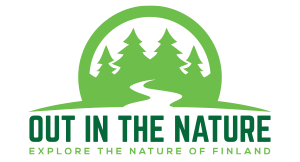
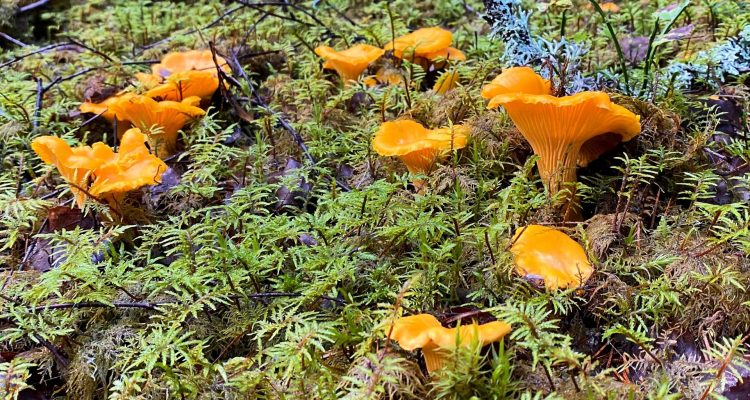
Has anyone been advised to “pre-boil before cooking”? One Finnish mushroom book recommends boiling *before* cooking “Akansieni”, which it classifies as Chlorophyllum Olivieri, whilst a second book classifies as Chlorophyllum Rhacodes. In contrast, English websites and videos advise simply chopping the raw mushroom before frying it. One website even advises against using excessive water when cleaning the Shaggy Parasol, in case the meaty taste is washed away.
Akansieni (Chlorophyllum Olivieri) is one of those that some people boil before cooking while others don’t. Officially it is recommended to be boiled, but some know from experience that their stomache can handle it. Boiling does take away some of the (slightly bitter) taste. I believe Chlorophyllum Rahcodes is nowadays classified as a totally different species to Akansieni, in Finnish it’s called Puistoakansieni as it grows in parks (=puisto).
Hi Jenni,
I want to get my boyfriend an amateur mushroom/fungi book that identifies edible varieties that can be found in Finland. Is there one in Finnish that you recommend?
Thank you!
Hi Naomi! For example Suomen sieniopas by Pertti Salo, Tuomo Niemelä, and Ulla Salo is versatile and comprehensive.
Hello. I am PJ I live in NY. I have been told Finland is happiest place on planet. At present I am in need of happiness . I am truly sad. Foraging for mushrooms elates me! I would like to come to Finland just to pick mushrooms. If anyone can advise or do foraging group trips, please let me know. I would appreciate the comradery Thank you
Hi there. I dont know about any long term trips but you can come for visiting the country and sign up for mushroom workshops while here. There’s some in helsinki and you can look them up on doerz.com